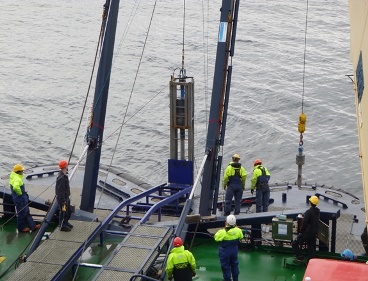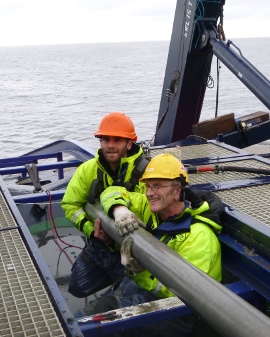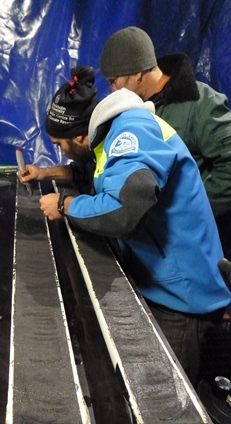”We’ve got the Holocene*!”
Most of the action of what I would like to report to you today happened already two weeks ago, but today we have finally had time to start looking at some of the results. When I was writing about taking sediment samples, I was always referring to the Multicorer because that is the tool we have, by far, used the most. But of course there are other methods, too; some of which we also have onboard. The most impressive one to me is the huge piston corer. Just for scaling: a typical Multicorer sediment core here is around 30cm long, 15cm if the mud is very stiff, and with comparably soft sediment the record is now at 56cm. With the piston corer, however, we could potentially get 12m long cores! Similar to ice cores that maybe more people are familiar with, sediment cores can also be used as archives of past climate, because (at least in most places) sediment is accumulated over time. How much is accumulated per year depends greatly on where you are; if there is extensive outflow from rivers or substantial coastal erosion or high marine productivity (i.e. lots of algae), accumulation rates are likely to be elevated. Just as an example: on a sediment core from this area that had been collected during an earlier expedition, we measured a rate of 0.24g of sediment per cm2 surface per year. That 17cm long core thus recorded the last century, roughly. If you want to work on longer timescales you need much longer cores – and that is where the piston corer comes into play. It will be used much more during the second leg of this expedition; we have just tried it at a couple of stations. Since it is such a massive piece of equipment we need a lot of support from the crew to deploy it: at least one operating the crane, two for different winches and one for the A-frame, but extra deck hands are always welcome. The most impressive one to me is the huge piston corer. Just for scaling: a typical Multicorer sediment core here is around 30cm long, 15cm if the mud is very stiff, and with comparably soft sediment the record is now at 56cm. With the piston corer, however, we could potentially get 12m long cores! Similar to ice cores that maybe more people are familiar with, sediment cores can also be used as archives of past climate, because (at least in most places) sediment is accumulated over time. How much is accumulated per year depends greatly on where you are; if there is extensive outflow from rivers or substantial coastal erosion or high marine productivity (i.e. lots of algae), accumulation rates are likely to be elevated. Just as an example: on a sediment core from this area that had been collected during an earlier expedition, we measured a rate of 0.24g of sediment per cm2 surface per year. That 17cm long core thus recorded the last century, roughly. If you want to work on longer timescales you need much longer cores – and that is where the piston corer comes into play. It will be used much more during the second leg of this expedition; we have just tried it at a couple of stations. Since it is such a massive piece of equipment we need a lot of support from the crew to deploy it: at least one operating the crane, two for different winches and one for the A-frame, but extra deck hands are always welcome.At Station 23 (the third try, aiming for 6m), after more than 2 hours of joint effort from crew and scientists a solid 4.5m core was welcomed on the aft deck! Main actors on the scientists’ side of the play were Tommaso Tesi and Pete Hill.  They got very excited when they realized that at the very low end of the core there were rocks. Because that meant that the piston corer had actually penetrated some really old sediment layer – “really old” meaning several thousands of years. As I tried to explain in my previous post, quite some energy is needed for moving stones. So if you find a rocky layer at depth in the sediment, you can assume that this is some kind of “paleo beach”. They got very excited when they realized that at the very low end of the core there were rocks. Because that meant that the piston corer had actually penetrated some really old sediment layer – “really old” meaning several thousands of years. As I tried to explain in my previous post, quite some energy is needed for moving stones. So if you find a rocky layer at depth in the sediment, you can assume that this is some kind of “paleo beach”.During the last ice age the sea level was much lower than today, in fact the whole Arctic Shelf was land at that time. At the end of the last Glacial Period, around 12 000 years ago the sea level started rising rapidly (relatively speaking, that is much faster than what we observe today) thereby causing massive erosion of the former shore. All this material got deposited on the sea floor, so the rocks and sand were eventually overlain by finer material (this is a very simplistic explanation). And that is exactly what we observed when we split the core in half today. Unfortunately you cannot really recognize the sand in the picture, but I can assure you that you can feel the difference when you touch it. 
|
| by Lisa Bröder |














